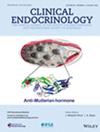Moderate Day-To-Day Variation in First-Morning Urine Total Luteinizing Hormone Levels Supports the Use of a Single Determination to Identify Imminent Puberty
Abstract
Objectives
We aimed to study the daily variation in first-morning urinary total luteinizing hormone (U-LH) determination and validate it as a noninvasive method for analyzing age- and pubertal stage-related changes in LH immunoreactivity (LH-ir) levels to predict imminent onset of central puberty.
Methods
We determined three consecutive first-morning total U-LH along with spot serum LH and follicle-stimulating hormone concentrations in 354 children (160 boys aged 2.8–17.8 yr and 194 girls aged 2.6–18.0 yr) with known pubertal stages. The samples were analyzed using an immunofluorometric assay (Delfia, PerkinElmer, Finland). The net day-to-day variation (net CV%) in U-LH-ir levels was calculated by subtracting the inter-assay CV% of the assay reported by the manufacturer from the gross inter-assay CV% calculated from three consecutive samples. U-LH-ir levels were classified as prepubertal (< 0.60 IU/L), highly likely pubertal (0.60–0.99 IU/L), and pubertal (≥ 1.00 IU/L).
Results
On average, the gross and net inter-assay CV% values for different U-LH concentrations measured on three consecutive mornings were 37.6% and 32.7%, respectively. Despite this level of day-to-day variation, only 3.6% of the test results for boys and 4.9% for girls were inconsistent in classifying total U-LH-ir levels as prepubertal, peripubertal, or pubertal. Our results showed that the activation of the hypothalamo-pituitary-gonadal hormone axis, which signals the onset of puberty, occurs at a similar age in both boys and girls, confirming our earlier findings that the timing of this process is independent of sex. Further, our findings confirmed that the onset of pubertal gonadotropin secretion in boys occurs already at a testicular volume of 1 to 2 mL, well before clear clinical signs of puberty.
Conclusions
A single first-morning total U-LH measurement appears to be a valid clinical test for classifying children or adolescents into prepubertal, peripubertal, and pubertal groups. This study validates the recently reported finding that the timing of central puberty onset is sex-independent. The duration between the initial activation of gonadotropin secretion and the first clinical signs of puberty was longer in boys than in girls.


 求助内容:
求助内容: 应助结果提醒方式:
应助结果提醒方式:


